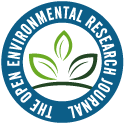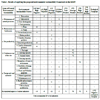- Home
- About Journals
-
Information for Authors/ReviewersEditorial Policies
Publication Fee
Publication Cycle - Process Flowchart
Online Manuscript Submission and Tracking System
Publishing Ethics and Rectitude
Authorship
Author Benefits
Reviewer Guidelines
Guest Editor Guidelines
Peer Review Workflow
Quick Track Option
Copyediting Services
Bentham Open Membership
Bentham Open Advisory Board
Archiving Policies
Fabricating and Stating False Information
Post Publication Discussions and Corrections
Editorial Management
Advertise With Us
Funding Agencies
Rate List
Kudos
General FAQs
Special Fee Waivers and Discounts
- Contact
- Help
- About Us
- Search
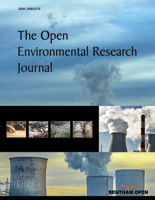
The Open Environmental Research Journal
Formerly: The Open Ecology Journal
ISSN: 2590-2776 ― Volume 16, 2023
- New Journal Website
- Journal Home
- Editorial Board
- Board Recruitment Workflow
- Instructions for Authors
- Plagiarism Prevention
- Fabricating and Stating False Information
- Research Misconduct
- Post Publication Discussions and Corrections
- Allegations from Whistleblowers
- Advertising Policy
- Short Guide
- Editorial Policies
- Publishing Ethics and Rectitude
- Quick Track Option
- Reviewer Guidelines
- Guidelines for Guest Editors
- Publication Fee
- Publication Cycle - Process Flowchart
- Archiving Policies
- Special Issues
Exploration of Ecological Footprint in the Kingdom of Saudi Arabian Developed Waterfronts: The Case of King Abdullah Seafront Park (KASP) – Dammam
Ali O. Al-Sulbi*
Abstract
Background:
Sustainable development identifies the requirements for the environmental enhancements while preserving a balance among environmental factors. Sustainable integrated systems reinforced or promoted the persistence of the structural and operational components into the natural component.
Objective:
The study aims to apply a modified ecological footprint model to assess how much the ecosystem functions were affected by the development of urban waterfronts in the Kingdom of Saudi Arabia.
Methods:
A modified ecological footprint model has been applied to assess the outcomes obtained from the ecosystem functions of urban waterfronts.
Results:
The study revealed alteration or embedment of natural processes in all developed urban waterfronts; leading to loss of biodiversity, diminishment of site productivity, and increase of hidden costs regarding maintenance and replacement. It has positive performance in biodiversity enrichment, continuous productivity, maintenance and enhancement of natural physical and biological processes.
Conclusion:
The sustainable designs for urban waterfronts should aiming for the enhancement of natural processes for the productivity of coastal areas.
Article Information
Identifiers and Pagination:
Year: 2018Volume: 11
First Page: 75
Last Page: 85
Publisher Id: TOECOLJ-11-75
DOI: 10.2174/1874213001811010075
Article History:
Received Date: 11/9/2018Revision Received Date: 25/10/2018
Acceptance Date: 1/11/2018
Electronic publication date: 9/11/2018
Collection year: 2018
open-access license: This is an open access article distributed under the terms of the Creative Commons Attribution 4.0 International Public License (CC-BY 4.0), a copy of which is available at: https://creativecommons.org/licenses/by/4.0/legalcode. This license permits unrestricted use, distribution, and reproduction in any medium, provided the original author and source are credited.
* Address correspondence to this author at the Department of Landscape Architecture, Imam Abdulrahman bin Faisal University, P.O. Box 2397, Dammam 31451, Kingdom of Saudi Arabia, Tel: +966 556609903; E-mail: aalsulbi@uod.edu.sa
| Open Peer Review Details | |||
|---|---|---|---|
| Manuscript submitted on 11-9-2018 |
Original Manuscript | Exploration of Ecological Footprint in the Kingdom of Saudi Arabian Developed Waterfronts: The Case of King Abdullah Seafront Park (KASP) – Dammam | |
1. INTRODUCTION
Ecological sustainability has recently emerged as a distinction to answer the critical, social, and environmental issues. Eco-friendly products or services were professed as a foundation of unrequired additional costs and alternative sources of competitive advantages. The environmental sustainability is challenged by different factors within the ecosystem, which are related to wellbeing of humans (Middleton, 2003Middleton, A (2003) The global casino: An introduction to environmental issues, 3rd ed. Arnold, London.). The ecosystem needs to be resilient and maintains ability to withstand severe environmental changes; and provides sufficient evolutionary capacity through the inherent ecological sustainability. The environmental changes are required to develop adequate ecosystem with appropriate alteration in the environmental conditions (Cabezas et al., 2003Cabezas, H, Pawlowski, C, Mayer, A & Hoagland, N (2003) Sustainability: Ecological, social, economic, technological and systems perspectives. Clean Energy Environmental Policy, 5(3-4), 167-80.). Thus, environmental sustainability or the maintenance of life-support systems is a prerequisite for any form of socio-economic development. The growing population of the world and weakening of natural environment, which is increasing in an unrecoverable way might develop persistent exploitation of natural resources and unsustainability in the economy. Such unsustainability could also affect human wellbeing and threaten life existance in the predictable future.
Ecological integrity is achievable, when environmental functions are properly maintained. It refers to the sustainable usage and management of natural resources within their resilience and regeneration limits. An ecosystem is considered sustainable and healthy, if the ability of its natural procedures to render effective services and goods required by an individual is highly positive. Such capacity is determined by several environmental characteristics related to the three significant environmental factors (land, air, and water) and the habitats, who sustain to support life (De Groot et al., 2003De Groot, R, Van der Perk, J, Chiesura, C & Van Vliet, A (2003) Importance and threat as determining factors for criticality of natural capital. Ecological Economics, 44(2), 187-204.
[http://dx.doi.org/10.1016/S0921-8009(02)00273-2] ). Accordingly, environmental sustainability requires maintenance of effective performance of essential ecological process and life-support systems (regulatory functions); productivity; habitat functionality in conserving biodiversity and evolutionary processes and supporting socio-cultural aspects (De Groot et al., 2003De Groot, R, Van der Perk, J, Chiesura, C & Van Vliet, A (2003) Importance and threat as determining factors for criticality of natural capital. Ecological Economics, 44(2), 187-204.
[http://dx.doi.org/10.1016/S0921-8009(02)00273-2] ).
Daly applied ‘strong to very strong’ sustainability framework and suggested four principles of sustainable development: a) limiting human activities to the ecosystem’s carrying capacity, b) effeciency of technolgical progress, c) maintaining delicate balance of utilizing renewable resources and their regeneration rates, and d) development of alternative resources to subtitute exploration of non-renewable resources (Daly, 1991Daly, H (1991) Elements of environmental macroeconomics. Ecological economics: The science and management of sustainability, Columbia University Press, New York 32-46.). Turner further developed these principles and reformulated them into a set of seven sustainability principles covering the four core categories of environmental functions (Turner, 1993Turner, R (1993) Sustainability: Principles and practice. Sustainable environmental economics and management: Principles and practice. Belhaven Press, London 3-36.).
Almheiri (2015)Almheiri, AK Is the United Arab Emirates capable to create a green and sustainable future? (unpublished Doctoral dissertation, The British University in Dubai (BUiD)). has explored assorted criteria to assess whether the United Arab Emiretes (UAE) is capable of developing a green and sustainable future. The study has critically observed UAE as a highest carbon footprint globally, which owes to its rapid progression over the last 20 years. UAE has opted essential measures to go sustainable and green in every sector of life and living as inspired by the enthusiastic and motivational leaders. In similar context, Salama et al. (2016)Salama, A M, Wiedmann, F, Khalfani, F A & Al-Maimani, A (2016) Dynamics of populations and urban open spaces in the emerging city of Doha. Gulf cities as interfaces, 181. have explored how integrated ecological systems restructured and modified the bio-climatic and socio-cultural conditions of the oasis towns in Oman. Higher adapatability and self-organization patterns are principally followed in such integration of environmental and anthropogenic aspects that enable guidance of developing sustainable future urbanism. Hoornweg (2015)Hoornweg, D (2015) A cities approach to sustainability. (Unpublished Doctoral dissertation)Department of Civil Engeenring, University of Toronto. Canada. has responded to the integrated shadow agreement for achieving greater sustainability that leads to a major sustainable development. At a metro-city level, sustainable development goals are applied and down-scaled through global boundaries and objectives. Thereby, emerging cities are comprehensively reviewing its green and sustainability projects and approaching its physical and socio-economic boundaries through sustainability cost-curves.
Towards the end of the twentieth century, some new concepts gained acceptance of ecological economists. One of the arguments had linked sustainability to the conservation of certain biophysical entities and processes. Those in the side of this argument have viewed the risks associated with depletion of resources that maintain the life-support functions of the ecosphere are unacceptable (Rees, 1992Rees, W (1992) Ecological footprints and approperiated carrying capacity: What urban economists leaves out. Environment and Urbanization, 4, 121-30.
[http://dx.doi.org/10.1177/095624789200400212] ). Ecological economists appreciated such assets as ‘constant capital stock’ criterion for sustainable development (Hanna et al., 2014Hanna, S, Harris, K, Osborne-Lee, I, Cesaretti, G, Misso, R & Andreopoulou, Z (2014) Global ecological human imprint, sustainable development and environment: Assessments and impacts. European Journal of Sustainable Development, 3, 1-24.
[http://dx.doi.org/10.14207/ejsd.2014.v3n3p1] ; Rees, 1992Rees, W (1992) Ecological footprints and approperiated carrying capacity: What urban economists leaves out. Environment and Urbanization, 4, 121-30.
[http://dx.doi.org/10.1177/095624789200400212] ).
The concept of Ecological Footprint (EF) has introduced in academic circles for the first time by Dr. William Rees and Mathis Wackernagel at the University of British Columbia in the early 1990s (Venetoulis & Talberth 2008)Venetoulis, J & Talberth, J (2008) Refining the ecological footprint. Environment, Development and Sustainability, 10, 441-69.
[http://dx.doi.org/10.1007/s10668-006-9074-z] . EF is defined as: a heuristic tool applied in sustainability analysis to measure the capacity of an ecosystem required to produce the resources an individual, a city, a country or humanity consumes; and to absorb the generated wastes using prevailing technology (Wackernagel et al., 2002Wackernagel, M, Schulaz, N, Deumling, D, Linares, A, Jenkins, M, Kapos, V & Randers, J (2002) Tracking the ecological overshoot of the human economy. PANS Proceedings of the National Academy of Sciences of the USA, 9266-71.; Ferguson, 1999Ferguson, A (1999) The logical foundations of ecological footprints. Environment, Development and Sustainability, 1, 149-56.
[http://dx.doi.org/10.1023/A:1010070927485] ). This and similar definitions are generalized to define EF as: ‘a standardized estimate of the Earth’s biological carrying capacity required to support humanity’s resource use and waste production’ (Venetoulis & Talberth, 2008)Venetoulis, J & Talberth, J (2008) Refining the ecological footprint. Environment, Development and Sustainability, 10, 441-69.
[http://dx.doi.org/10.1007/s10668-006-9074-z] . Such definitions do not provide a way to measure pollution effect on an environmental area, in addition they do not account for human consumption of fresh water.
Mainly there is two main methods for caculating EF (Newman & Jennings, 2008Newman, P & Jennings, I (2008) Cities as sustainable ecosystems: Principles and practice. Islandpress, Washington.); Chambers, Simmons, & Wackernagal (2000)Chambers, N, Simmons, C & Wackernagal, M (2000) Sharing nature’s interest: Ecological footprint as an indicator of sustainability. Earthscan, London.: (a) Compound method orginally developed by Wackernagal & Rees (1996)Wackernagal, M & Rees, W (1996) Our Ecological footprint: Reducing human impacts on the Earth. New Society Press, Philadelphia. to measure EF at national level (Wackernagal & Rees, 1996Wackernagal, M & Rees, W (1996) Our Ecological footprint: Reducing human impacts on the Earth. New Society Press, Philadelphia.); and (b) Component method developed by Best Foot Forward Firm to measue EF at regional Level (Simmons, Lewis & Barratt, 2000Simmons, C, Lewis, K & Barratt, J (2000) Two feet - two approaches. Ecological Economics, 32, 375-80.).
The significance of this study is; therefore, subjected towards the ecological footprints in Saudi Arabia that highlights the importance of sustainable development. The achievements of social and economic development, which ensure high standard of living in present and future have been highlighted in this study. A balance between feeling of well-being and requirements of human to improve lifestyle can be maintained by recognizing sustainability of all developmental changes. In contrast, preserving natural resources and ecosystems functionalities may also help to have an enhanced lifestyle. Therefore, the study is intended to explore the ecological footprints of developed waterfronts in Saudi Arabia by analyzing the King Abdulla Seafront Park (KASP).
2. METHODOLOGY AND TOOLS
Several frameworks have been developed to assess environmental sustainability for different purposes. Gerbens-Leenes, Moll, and Uiterkamp in their research discussed number of studies to set a measuring method for sustainable food production (Gerbens-Leenes, Moll, & Schoot Uiterkamp, A. 2003Gerbens-Leenes, P, Moll, H & Schoot Uiterkamp, A (2003) Design and development of a measuring method for environmental sustainability in food production. Ecological Economics, 46, 231-48.
[http://dx.doi.org/10.1016/S0921-8009(03)00140-X] ). They evaluate three environmental indicators that address global environmental issues of energy, land and water, which expressed in three performance indicators. Based on that Al-Sulbi proposed framework emphasises five major elements to be importantly considered in modification of natural ecosystems:
- Maintenance and enhancement of natural processes.
- Enhancement of biodiversity.
- Continuity of site productivity.
- Continuous use of the modified site at different times and seasons, and
- Environment and physical quality (Al-Sulbi, 2011Al-Sulbi, A (2011) Proposed framework to measure environmental sustainability of the developed waterfronts (King Abdullah Park - Dammam). Built and Natural Environment Research Papers, 4, 34-46.).
The framework sets and applies a seven-level scale (-3 to +3) to assess the impacts on indicators of the five major elements listed above in the King Abdullah Seafront Park (KASP) located along the Dammam Waterfront.
This study modifies and merges the theoretic approach proposed by Rosa and Palma for “understanding the reality” and the framework developed by Al-Sulbi for measuring environmental sustainability (Rosa & Palma, 2003Rosa, F & Palma, M (2003) Historic urban landscape approach and port cities regeneration: Naples between identity and outlook. Sustainability, 4268-87.; Al-Sulbi, 2011Al-Sulbi, A (2011) Proposed framework to measure environmental sustainability of the developed waterfronts (King Abdullah Park - Dammam). Built and Natural Environment Research Papers, 4, 34-46.). The first examined 16 indicators related to the four dimensions of sustainability in general, using a six-level scale ranging from (0) = null to (5) = very high; while the other examined 22 indicators connected to five elements of environmental sustainability on a seven-level scale ranging from (-3) to (+3) to assess the level of increase and/or decrease in the performance of each of the 22 indicators.
In the current study, the 22 indicators (can be called factors) of environmental sustainability have been used as a base linking EF to environmental sustainability to explore EF of the urban waterfronts development in the KSA (Fig. 1 ). Assumption of EF of any action related to waterfront development has been based on the definition of environmental sustainability as “long-term maintenance of ecosystem components and functions for the present and future generations to meet their needs and survival with no harms to environmental resources and communities’ health” (Al-Sulbi, 2011). The modified model examines the 22 indicators of environmental sustainability for their contribution in ecological footprint (Table 1). It applies an eight-level scale ranging from (-4) = very high negative to (+4) = very high positive to evaluate the KASP environmental performance, and calculate its EF level based on the reactions of all environmental sustainability indicators.
). Assumption of EF of any action related to waterfront development has been based on the definition of environmental sustainability as “long-term maintenance of ecosystem components and functions for the present and future generations to meet their needs and survival with no harms to environmental resources and communities’ health” (Al-Sulbi, 2011). The modified model examines the 22 indicators of environmental sustainability for their contribution in ecological footprint (Table 1). It applies an eight-level scale ranging from (-4) = very high negative to (+4) = very high positive to evaluate the KASP environmental performance, and calculate its EF level based on the reactions of all environmental sustainability indicators.
 |
Fig. (1) Methodological process of assuming EF of actions related to waterfronts development. |
The KASP's EF has been assessed by the researcher based on his previous work and experience, supported by the opinions of experts in the fields of landscape planning and management; and environmental assessment and management from environmental agencies and local municipalities. For example, microclimate modification has low negative impacts (-1) on the KASP (Table 1) as it is contributes to reradiation from the hard surfaces. Also due to exposure of the site, it subject to strong salty splash which affects both hard and soft materials.
3. CASE STUDY: THE KING ABDULLA SEAFRONT PARK (KASP)
The southern part of the Tarout Bay is occupied by the Dammam waterfront (Fig. 2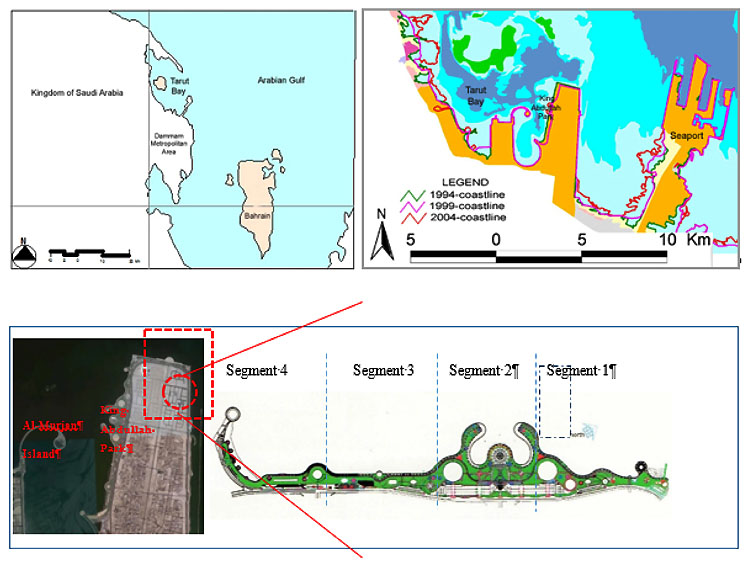 ), which is situated between King Abdulaziz Seaport at the south and Seahat at the north. King Abdullah Seafront Park (KASP) west oriented face Al-Murjan Island and is extended about 3.5 km at the middle of the Dammam waterfront. The continuous shift of coastline westward during the years 1994 – 2004 resulted from the different reclamation operations (Al-Sulbi, 2011Al-Sulbi, A (2011) Proposed framework to measure environmental sustainability of the developed waterfronts (King Abdullah Park - Dammam). Built and Natural Environment Research Papers, 4, 34-46.). Furthermore, the construction of KASP greatly affected coastal ecosystems due to large land fillings.
), which is situated between King Abdulaziz Seaport at the south and Seahat at the north. King Abdullah Seafront Park (KASP) west oriented face Al-Murjan Island and is extended about 3.5 km at the middle of the Dammam waterfront. The continuous shift of coastline westward during the years 1994 – 2004 resulted from the different reclamation operations (Al-Sulbi, 2011Al-Sulbi, A (2011) Proposed framework to measure environmental sustainability of the developed waterfronts (King Abdullah Park - Dammam). Built and Natural Environment Research Papers, 4, 34-46.). Furthermore, the construction of KASP greatly affected coastal ecosystems due to large land fillings.
 |
Fig. (2) Location of Tarout Bay and the seafront (top); and (bottom) The KASP location and its Four segments emphasizes the reshaping the coastline and creation of small bays. |
The KASP was opened in July 2007 for the local public on an area of about 500,000 m2 of the coast and comprised of 17,000 m2 festival plaza, which rose to more than five meters above the sea level. The three other platforms of more than 15,000 m2 each rose to four meters high. The green areas of 250,000 m2 supported with car parking for 3,000 cars, 14 children play areas, and 8 km long jogging and walking track (Fig. 2 ). The filling materials of 500,000 m3 were reclaimed and reformed over the coastline.
). The filling materials of 500,000 m3 were reclaimed and reformed over the coastline.
Within the KASP, four segments can be easily identified based on their exposure to the open sea, and how each of these segments influenced by climatic and maritime factors. However, water depth at the coastline in all four segments is exceeding two meters because of extensive dredging and landfilling of the area. The coastline has been transformed and led to the creation of series of curvilinear pockets as a result of landfilling and dredging operations with heavy and strong waves but low currents and stagnant water. It affects number of ecological processes instead of enhancing coastal sustainability, which leads to negative ecological footprints of some indicators such as equivalence factor results in rubbish and litter accumulations, growth of algae, and bad odors (Ruževičius, 2010Ruževičius, J (2010) Ecological footprint as an indicator of sustainable development. Economics and Management, 15, 711-8.). In addition, such wave actions affect coastal defenses and stimulate salt splash that causes serious damage to site furniture.
In case of Yanbu Industrial City’s waterfront development, the nature of the coast has been neglected. Several seasonal streams, which are important for growth and sustainability of mangrove swamps ecosystem was disconnected from the sea and a parallel deep canal has been created to isolate such valuable ecosystem from its source of life (Fig. 3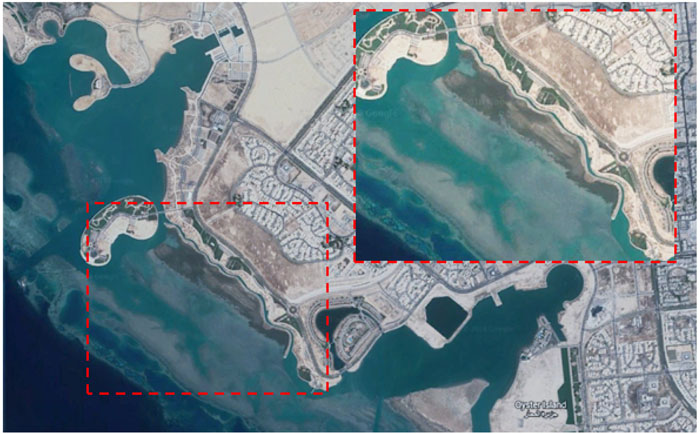 ).
).
4. SITE INVENTORY AND ANALYSIS
The segment no. 1 occupies the northern far end of the park and is fully exposed to the open sea; subjected to strong and heavy wave actions gradually driven between Al-Murjan Island and coasts of Al-Qateif and Tarout Island. The direction of wind from north to west accelerates the tidal currents and wave actions as a part of open sea that possesses no intertidal zone to break the pressure of waves. The base materials present underneath is eroded as a result of continuous generation powerful waves towards constructed wave barrier, which results in collapse of the constructed barrier (Fig. 4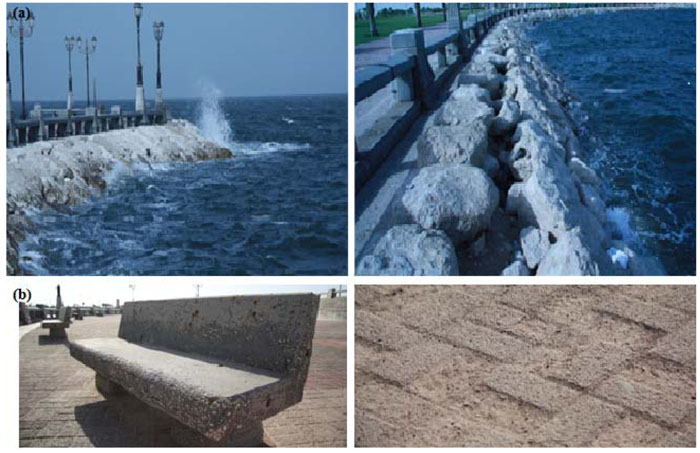 ).
).
 |
Fig. (4) (a) This segment is subjected to strong waves due to disappearance of intertidal zone (b) Effects of huge swash on the site furniture and paved surfaces along this segment. |
Segment 2 is the central festival platform surrounded by two bays on both sides, where the main festival plaza rises more than 5 m above the sea level and approximately 3.5 m above the surrounding walkways (Fig. 5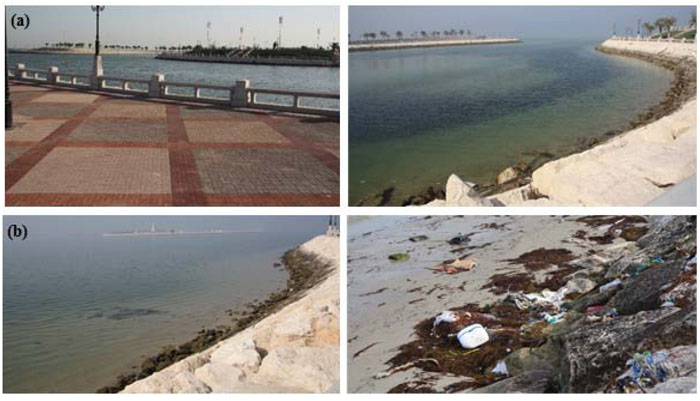 ). The northern peninsula protects this segment from the negative effects of strong waves. The growth of algae is accelerated by the north-western winds, which favors the accumulation of litter and rubbish in the two created bays (Fig. 5
). The northern peninsula protects this segment from the negative effects of strong waves. The growth of algae is accelerated by the north-western winds, which favors the accumulation of litter and rubbish in the two created bays (Fig. 5 ).
).
 |
Fig. (5) (a) Reshaping the coastline created semi-circular wave-protected areas in this segment (b) Accumulation of litters and rubbish at the ends of the created bays in the second segment. |
Segment 3 is partially protected by the tidal currents and strong waves by the artificial Al-Murjan Island, which is located at the central part of the KASP (Fig. 6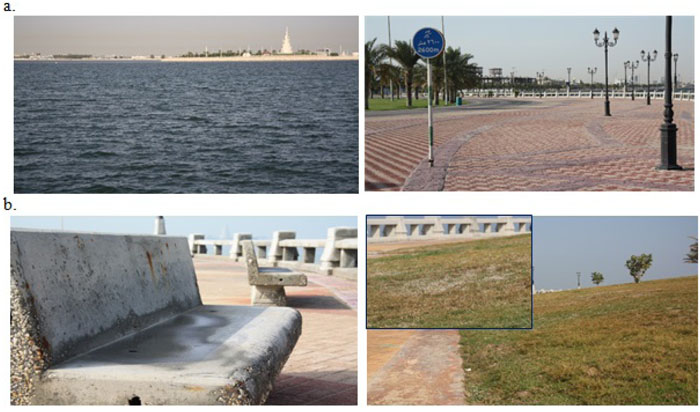 ). Water becomes stagnant for long time due to weak tidal currents, and consequently unpleasant odors might result from litter and algae decay. However, there is a clear sky and high temperature in this area during the summers, which facilitates the growth of algae (Eshqi, 2016Eshqi, A (2016) An Expert warning of Environmental Crisis Hits As-Salam Lagoon in Jeddah (Article in Arabic). Available online https://sabq.org (accessed on 28 October 2016).). The growth of aquatic algae and plants is accelerated when they receive excessive organic and nutrients rich diet along with high temperature (Mandorah, 2005Mandorah, A (2005) Environmental degradation of the KSA coastal zones: The red sea and the arabian gulf Workshop of preparing regulations and guidelines for operation and management of coastal areas inMinistry of Municipal and Rural Affairs, Saudi Arabia.). It may lead to the occurrence of various toxic phytoplankton, which is scientifically known as green or red tide phenomena (Al-Mansi, 1999Al-Mansi, A (1999) Ecosystems of the red sea and the Arabian GulfAl-Humadhi Press, Riyadh. (in Arabic); Eshqi, 2016Eshqi, A (2016) An Expert warning of Environmental Crisis Hits As-Salam Lagoon in Jeddah (Article in Arabic). Available online https://sabq.org (accessed on 28 October 2016).).
). Water becomes stagnant for long time due to weak tidal currents, and consequently unpleasant odors might result from litter and algae decay. However, there is a clear sky and high temperature in this area during the summers, which facilitates the growth of algae (Eshqi, 2016Eshqi, A (2016) An Expert warning of Environmental Crisis Hits As-Salam Lagoon in Jeddah (Article in Arabic). Available online https://sabq.org (accessed on 28 October 2016).). The growth of aquatic algae and plants is accelerated when they receive excessive organic and nutrients rich diet along with high temperature (Mandorah, 2005Mandorah, A (2005) Environmental degradation of the KSA coastal zones: The red sea and the arabian gulf Workshop of preparing regulations and guidelines for operation and management of coastal areas inMinistry of Municipal and Rural Affairs, Saudi Arabia.). It may lead to the occurrence of various toxic phytoplankton, which is scientifically known as green or red tide phenomena (Al-Mansi, 1999Al-Mansi, A (1999) Ecosystems of the red sea and the Arabian GulfAl-Humadhi Press, Riyadh. (in Arabic); Eshqi, 2016Eshqi, A (2016) An Expert warning of Environmental Crisis Hits As-Salam Lagoon in Jeddah (Article in Arabic). Available online https://sabq.org (accessed on 28 October 2016).).
Segment 4 is a calm area comprising the far south end of the KASP. The artificially constructed Al-Murjan Island has protected this area against the effects of tidal and wave currents. The factors that carry litter and rubbish to far end of coast and water body are the calm and gentle effects and change of wind direction. It originates mushroom, flourish algae, and accelerate decomposition of accumulated organic litters.
The indirect and direct observations of environmental sustainability have been used for data collection. However, the ecological footprint of the KASP’s coastal development has been measured by the application of indicators to the designed framework. The application revealed results as summarized in Table 1.
It is noticeable that 17 of the 22 environmental sustainability indicators have negative Environmental Factors (EF) varying from very high to low; scoring total accumulated negative of (-39). Whereas, the positive EF of the other five indicators score only (+10), which in total result with an average of (-29), indicating average negative EF. Interpretation of the results depend on the total scores regarding the environmental sustainability indicators. The action considered very high negative EF when the accumulated total score exceeds to (-44); high negative between (-44 and -33); average negative between (-32 and -22); and low negative less than (-21). Similarly, EF is low positive if it is less than (+21); Average positive between (+22 and +33); Positive between (+33 and +44); and High positive if it is more than (+44).
In the measurement framework, most of the indicators have negatively contributed to the seafront environmental sustainability. The pushing of coastline towards deep water has resulted in increased tidal activities and wave actions in the two northern segments due to their connectivity and exposure to the open sea. The significant effects on the coastal processes have been revealed after the process of modification. The massive damage occurred to the soft and hard landscape elements at distance of 10 m due to generation of splash after hitting of strong currents and waves at the coast. The continuous spill of salty splash causes pavement of north and northwest areas along with the components of street furniture, which faced erosion and appear ugly. The serious damage has extended to green areas nearby from the cover areas of the sound ground, causing distortion of the plants including shrubs and trees. The soil erosion and accumulation of salts on hilly areas is contributed by the spread of salty swash to the nearby hard and soft areas.
5. DISCUSSION
The complexity of biochemical and interrelated physical processes has described the coastal areas as the most sensitive ecosystems. Thus, modification of coastline and/or alteration of these physical and biochemical processes will cause disturbance and instability of the whole ecosystem. The dominant processes and actions of waves, currents, and tides of coastal areas are related to the functionality of ecosystems in a sustainable manner. The recreational and tourism facilities are considered as degrading processes that need dredging shallow water areas nearby and land filling on intertidal habitats.
Considering the seafront environmental sustainability, Girard, Kourtit & Nijkamp (2014)Girard, L F, Kourtit, K & Nijkamp, P (2014) Waterfront areas as hotspots of sustainable and creative development of cities. Sustainability, 6, 4580-6. have asserted that the possible development of the urban system is emerged from the environmental management with respect to local regeneration. The findings of the study are consistent with the current study that EF of seafront environmental sustainability is negatively associated to the ecological development. Girard, Kourtit & Nijkamp (2014)Girard, L F, Kourtit, K & Nijkamp, P (2014) Waterfront areas as hotspots of sustainable and creative development of cities. Sustainability, 6, 4580-6., in this regard, asserted that environmental circumstances are not well suited to a preferable quality of life due to social and environmental degradation near the port. Leonard (2016)Leonard, AR (2016) Seaside town regeneration and the interconnections between the physical environment, key agencies and middle-life migration. Journal of Policy Research in Tourism, Leisure and Events, 8(2), 107-26.
[http://dx.doi.org/10.1080/19407963.2015.1079532] has supported the current study findings and asserted that socio-economic evolution and change are influenced by changes in the physical adaptation and environment. The interconnections present between the images and labels, key agencies and physical environment are understood from the local regeneration changes.
Pagán (2016)Pagán, J (2016) Sustainable Development City-Beach in Alicante. Urban Regeneration & Sustainability, 344. has indicated that the attraction of the region, and the mobility of the city on the coast are increased from the union of diverse marine area and the remains of breakwaters along the coast. In the similar context, Usón Guardiola, Vives Rego & Uson Maimo (2016)Usón Guardiola, E, Vives Rego, J & Uson Maimo, D (2016) Case study of urban property development along the Barcelona seafront employing sustainable strategies. Conference Proceedings of the 4th Annual International Conference on Architecture and Civil Engineering, 359-66.
[http://dx.doi.org/10.5176/2301-394X_ACE16.120] have mentioned that the environmental impact of urban development is tackled by reducing carbon emissions and limiting global warming. Global sustainability can be achieved by increasing the simple and understandable strategies that allow local processes and waste production in creating a liveable and lively city.
A number of tourists are attracted by the positive aspects of KASP as a developed area during the mild climatic conditions. There is a sharp decrease in the number of tourists during the day time and summers. The area is divided into soft and hard surfaces in equal proportions with complete elimination of climatic factors and environmental characteristics of the site. There are decreased number of shading devices and protection against sun, harsh wind, and salty swash, which reduces the area usability during summers. The carrying capacity of the place, personal space, and feeling of privacy were almost lost as the number of tourists increased in the favorable seasons. Inhumanity of open space and the way, it was designed as vast grass and paved flat areas have given a rise to the number of negative impacts; such as the amount of abandoned rubbish and vandalism practices against site elements. KSA coastal areas have witnessed massive development since the middle of 1970s, when Jeddah waterfront was developed as the first reclamation on the western coast of the country. Historical trends of the coastal and waterfronts development in the Arabian Gulf Countries (in general) went through three periods. Initially, it is characterized by ‘uncontrolled growth’ of the coastal settlements during 1950s and 1960s; then ‘the remedy period’ of reclaiming the lost connection with the seafronts during 1970s and 1980s, and finally the present period of ‘unplanned problems’ raised as consequences of the first two periods (Theobald et al., 2000Theobald, D, Hobbs, N, Bearly, T, Zack, J & Riebsame, W (2000) Incorporating biological information in local land-use planning decision making: Designing a system for conservation planning. Landscape Ecology, 15(1), 35-45.
[http://dx.doi.org/10.1023/A:1008165311026] ). During first two periods, oil revenues had fueled the initial development boom in major coastal cities, resulted in massive uncontrolled expansion. City of Jeddah; the arrival destination of pilgrims and the second important city in the Kingdom of Saudi Arabia; were expanded outwards (east and north) and turned its back to the sea for decades. It was the first waterfront development project in the KSA to re-establish the lost relationship with the sea. The design of the waterfront emphasized the modification and reshaping of the coastline as series of bays and lagoons. This concept claimed landfilling of large areas of wetlands, shallow waters and coastal habitats. Climatologically, vast pavement areas absorbed heat at the daytime and re-radiated it at night that increased temperature of the area by 5oC, as compared to the surroundings. It happens especially if the humidity is relatively high due to which the sites are less used at hot day times. Development of coastal areas to meet the requirements of urban waterfront parks necessitate more attention to the sensitivity of such areas, their ecosystem components, coastal processes, and ecological interactions. Great pressure is faced by the development authorities in maintaining environmental sustainability and providing coastal recreational facilities to these sensitive areas.
CONCLUSION
In case of KSA, these issues are rarely considered in all developed urban waterfronts; which in turn, seriously affected environmental quality and have resulted in an accumulative negative EF. In the design and implementation of KASP, almost all indicators of environmental sustainability were ignored, leading to a total accumulative average negative EF. Urban waterfronts are huge projects, which involved extensive modification of coastal areas. The contribution to social, environmental, and economic sustainability is identified through environmental impact assessment studies and careful planning. The sustainable designs for the fresh waterfronts aim for the enhancement of natural processes for the productivity of coastal areas. Therefore, it is recommended that coastal environment should be dealt sensitively within the vicinity of urban area.
CONSENT FOR PUBLICATION
We obtained the written informed consent from each subject or subject's parent.
CONFLICT OF INTEREST
The research has no conflict of interest and is not funded through any source.
ACKNOWLEDGEMENTS
The author is very thankful to all the associated personnel in any reference that contributed in/for the purpose of this research.



